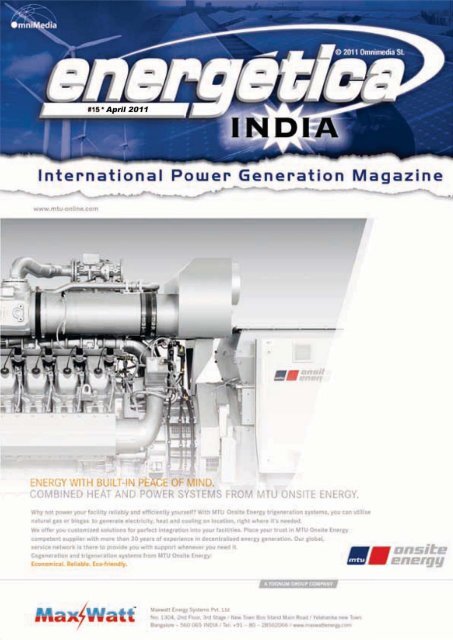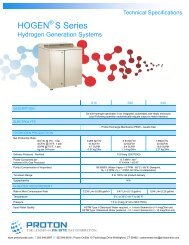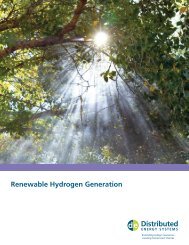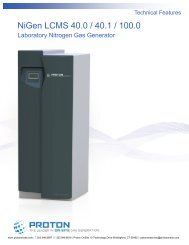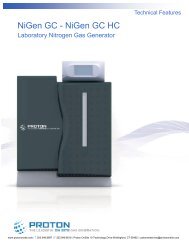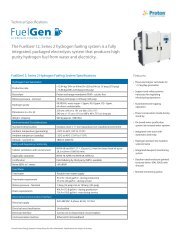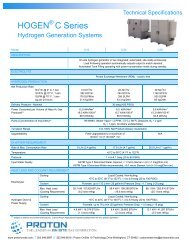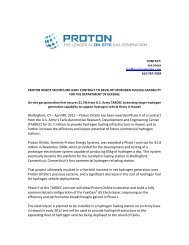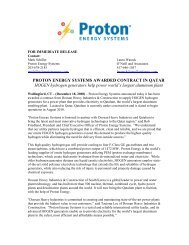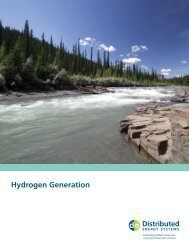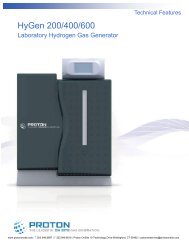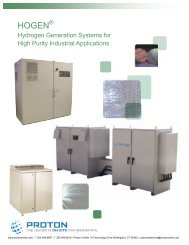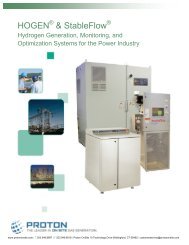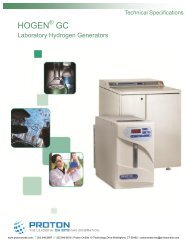Untitled - Proton OnSite
Untitled - Proton OnSite
Untitled - Proton OnSite
Create successful ePaper yourself
Turn your PDF publications into a flip-book with our unique Google optimized e-Paper software.
HYDROGEN<br />
Understanding Hydrogen and it’s Impact<br />
on Power Producer’s Bottomline<br />
RAJEEV BHALLA & SIDDHARTH RASTOGI FOR MVS ENGINEERING – INDIA; THOMAS SKOCZYLAS FOR PROTON ONSITE – USA.<br />
Unknown to many, Quality of Hydrogen in a Hydrogen-cooled Turbine Generator plays an<br />
important role for the bottomline of a power generation utility. Some power generation<br />
companies are paying attention to this and deriving benefits including improved efficiency,<br />
better yields from same fossil burn. We explore the simple physics behind this and why<br />
the power generation industry needs to pay close attention to this.<br />
Purpose of Hydrogen cooling in<br />
Turbine Alternators<br />
Hydrogen is used for cooling Generator’s Rotor<br />
windings in Turbine Generator (TG), for<br />
the following reasons:<br />
<br />
Hydrogen has one of the lowest gas densities<br />
thus offering least resistance to the<br />
rotation of the Rotor within the Generator.<br />
In turn there is lower energy requirement<br />
for rotating the machine countering<br />
the offered drag / windage factor.<br />
<br />
Hydrogen offers the highest heat conductivity<br />
property compared to Air or other<br />
gases and hence, is a very efficient carrier<br />
of generated heat, from a electrical machine.<br />
From hereon, the heated Hydrogen<br />
is carried to the outside of the machine,<br />
where it is cooled and returned continuously,<br />
in closed loop circulation.<br />
These are the two reasons why Hydrogen<br />
is the preferred gas for Large Electrical<br />
rotating machine cooling. Predominantly<br />
used for high rotational speed machines,<br />
where drag losses play significant absorbed<br />
energy impact. Therefore Hydrogen cooling<br />
is popular in machines typically 100 MW or<br />
larger Steam Turbine, and / or, Gas Turbine,<br />
driven Generators.<br />
Importance of Maintaining<br />
Hydrogen Pressure, Purity and<br />
Dryness<br />
<br />
A limited, higher pressure of Hydrogen<br />
purge maintained within the Rotor rotating<br />
space, increases the gas density. This<br />
increased density increases the specific<br />
gas conductivity (v/v). Meaning, a lesser<br />
volume of Hydrogen gas moved across<br />
the rotating machine will effectively remove<br />
all the heat. Usually the Hydrogen<br />
pressure is maintained in the range 3 to<br />
4 Bar(g).<br />
<br />
Hydrogen has molecular weight of 2,<br />
while Air is 29. This means Air weighs<br />
more than 14 times compared to Hydrogen.<br />
The impurity which will afflicts Hydrogen<br />
purge is Air due to limited ingress.<br />
It is important to note, each percentage<br />
point increase of Air impurity in Hydrogen<br />
will have a 14 times exponential increase<br />
in Gas density within the Rotor space in<br />
the Generator. Thus, the increased drag<br />
caused is also exponential in value. The<br />
best performance will be derived only<br />
when the Hydrogen purity within the TG<br />
is maintained near constant at 99.5%.<br />
<br />
Most people understand this aspect well,<br />
and many Generator manufacturers even<br />
provide/recommend a Hydrogen gas drier<br />
within the Hydrogen gas closed-loop circulation.<br />
Wet gas is severly detrimental to<br />
the life of the windings due to increased<br />
risk of corrosion and insulation failure.<br />
Hence, it is very important that purge gas<br />
Dew point be maintained as low as possible.<br />
Usual industry standard is to achieve<br />
control at (-) 20°C, or lower.<br />
Industry practice for Hydrogen<br />
control in Turbine Alternators<br />
<br />
This is easily achieved using good quality<br />
down stream gas pressure regulating<br />
valves. It is recommended to use a well<br />
designed valve, and never think an ordinary<br />
air pressure regulator will, do a reliable<br />
job.<br />
<br />
Most conscientious power generation<br />
companies use online Gas analysers and<br />
are content maintaining the TG purge purity<br />
in a range of 98% to 99.5%. They utilize<br />
the Bleed-and-Feed control for maintaining<br />
purity by sending out an operator<br />
to manually adjust the fresh Hydrogen gas<br />
inlet and TG vent valve, to replace some<br />
gas within the Rotor space thus improve<br />
purity to the max. This process is done<br />
once in 2 – 3 hours. Good, but not good<br />
enough! As one can easily calculate, this<br />
constant fluctuation of purity results in<br />
average purity of Hydrogen of around 98<br />
to 98.5%.<br />
<br />
TGs which have within loop Hydrogen<br />
38 APRIL11 energetica india
HYDROGEN<br />
® . ® .<br />
Dryer are the lucky ones. They at least<br />
have the technical facility to keep Hydrogen<br />
Dew point in check. Many Power<br />
Utilities are using commercially available<br />
Hydrogen gas supplied in Gas cylinders<br />
or Bullets. Commercial Hydrogen is typically<br />
procured from the off-gas stream<br />
of process industries such as Chlor-Alkali<br />
plants. This Commercial grade Hydrogen<br />
of 99.8% purity (or worse), and questionable<br />
Dew point is wet (saturated). Ensuing<br />
wet gas affects the Generator winding<br />
life. One needs superior quality gas<br />
to keep the Dew point low. Just like, you<br />
need clean water, to wash dirty clothes. Either<br />
this be done by online Hydrogen dryer<br />
or use Hydrogen gas of superior Dew<br />
point (-) 60°C or better, and successfully<br />
use the ‘displacement method’ to control<br />
purge atmosphere Dew point.<br />
Financial Impact of Low purity<br />
The loss is so large that we must not ignore it!<br />
Data gleaned from Turbine Generator OEM,<br />
indicate, windage loss of 250 kW (thereby<br />
loss of 250 kW extra saleable power), for<br />
every one percent reduction in Hydrogen<br />
purity 1 . Every 1% lower Hydrogen purity, will<br />
1 As reported in article – “Seals from<br />
Aerospace”published in Power Engineering<br />
magazine dated Nov. 1, 2004. Authors: Peter<br />
translate to Rs. 4 million (Rs. 40 Lacs) potential<br />
loss per year 2 .<br />
Loss due to poor H2 Pressure<br />
Management<br />
Low Hydrogen pressure will lead to lower<br />
mass – heat conductivity. The Hydrogen circulation<br />
is usually through a fixed volume<br />
Hydrogen circulation blower. Lower heat<br />
removal will heat up the Generator and the<br />
operator will be forced to operate the TG at<br />
lower load. And, again there is loss of revenue!<br />
Higher Hydrogen pressure will lead to<br />
higher leakage from Generator’s Shaft seals<br />
and body. This will require more Hydrogen replacement<br />
volume to maintain the pressure.<br />
Loss due to Dew point<br />
Wet gas within the Generator’s Rotor space<br />
will lead to pre-mature windings insulation<br />
failure. Further revenue loss and repercussions,<br />
need not be extolled.<br />
How do <strong>Proton</strong> <strong>OnSite</strong> products help<br />
® (Automatic Purity, Pressure<br />
and Dew Point control)<br />
Rice, Siemens Westinghouse Power Corporation<br />
and Anastassios Dimitriadis, Siemens Power<br />
Generation.<br />
2 Assuming power selling agreement of Rs. 2.0 and<br />
average 8000 running hours for the TG per annum.<br />
StableFlow ® can be easily retrofitted to the<br />
Turbine Generator’s Hydrogen (sample)<br />
line without disturbing the existing Hydrogen<br />
piping and instrumentation. Unlike<br />
existing analyzers and instrumentation<br />
that simply does passive management,<br />
StableFlow ® actively and automatically<br />
controls the Hydrogen Pressure, Purity &<br />
Dew point simultaneously, by controlling<br />
the “vent rate” and new Hydrogen feed<br />
flow. It maintains all three parameters,<br />
within very close limits of the set points<br />
for Pressure, Purity and Dew point.<br />
® <br />
HOGEN ® (PEM Water Electrolysis Type H2<br />
Generators) delivers 24 x 7 High quality<br />
Hydrogen directly to the Turbine Generator.<br />
Hydrogen gas is available on-demand<br />
closely following consumption pattern for<br />
capacity control across 0 – 100%, at 15<br />
or 30 Bar(g), 99.9995% pure, and at (-)<br />
70°C Dew point. Having a HOGEN ® is like<br />
having a cylinder that never goes empty.<br />
HOGEN ® conforms to the world leading<br />
international codes and standards and is<br />
the only Hydrogen Generator of its type<br />
that can be installed in a safe area.<br />
Both above products, each, by themselves<br />
help earn more money for the Power<br />
generation utility, and if used together, are a<br />
formidable money making machine!<br />
energetica india<br />
APRIL11<br />
39


